
D P Agrawal

Showing all 9 books





The treatise on Corporate Governance is a maiden attempt to holistically ponder over entire spectrum of Initiatives & Reforms undertaken in developed world and replicated/adapted in Indian setting at one place. The study of corporate governance, relatively a new discipline, has become imperative due to unexpected collapse of high profile giant corporate houses globally. Corporate Governance has now become an integral part of everyday business life. In its ...

Metallurgy had begun in the Indian subcontinent around 6th Millennium BCE. But unlike other metals zinc appeared much later, only a few hundred years ago, on the scene. Being volatile it is one of the most difficult metals to smelt as it forms vapour in the furnace when heated o around 1000oC. Though various claims have been made regarding its remote antiquity across Asia and Europe, only Zawar in India has the oldest archaeological record of pure zinc production ...

The indus Civilization is as old as the ancient civilizations of Eqypt, Mesopotamia and China. It is spread over an area of more than a million sq km, an area much bigger than the Mesopotamian and the Egyption Civilizations.

This book on South Asian Prehistory covers the story of humans from the beginning of the Stone Age to the advent of agriculture and animal husbandry. The authors have not confined themselves to merely typological descriptions of tools but have tried to look beyond - to the humans and their society that created them. As the authors have done considerable work on palaeoenvironment of Kashmir and Rajasthan, they have provided an environmental backdrop to the history ...

Recent years have witnessed a flurry of archaeological activity in India, Pakistan and other parts of South Asia, producing an enormous wealth of data and consequently making most of the general books on South Asian Archaeology out of date. This encouraged the authors to attempt a balanced and holistic synthesis of the new evidences and research material. To do justice to the vast data, the project Archaeology of South Asia) was planned in two volumes. The story ...

This book on the Central Himalayas surveys the cultural and archaeological evidence in an inter-disciplinary perspective. Though a variety of interdisciplinary data have been used, the approach is holistic. The book is focused on Kumaun and Garhwal, yet it is related to the sub-continental framework with a global backdrop. The main emphasis has been on prehistory. This is the first systematic and scientific documentation of rock art and cup marks found in the ...


The Indus Civilization is as old as the ancient civilizations of Egypt, Mesopotamia and China. It spreads over an area of more than a million sq km, an area much bigger than the Mesopotamian and the Egyptian Civilizations which are famous for their sepulchral splendour. Though technologically innovative, the Indus Civilization in marked by a modesty and the functionality of its architecture and artifacts. After the classical reports of the ...

The Traditional Knowledge Systems (TKS) are the corpus of accumulated folk knowledge gained through trial and error through millennia. This folk knowledge therefore has a parental relationship to the elite science. The micro-variations of the ambient harsh environment of the hills have been responsible for the extremely rich community knowledge systems and a biodiversity necessary for sustainability of human life here. The mountain people ...
